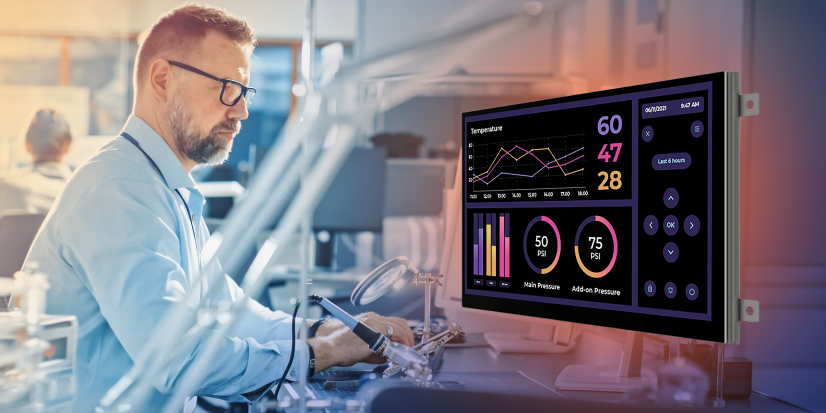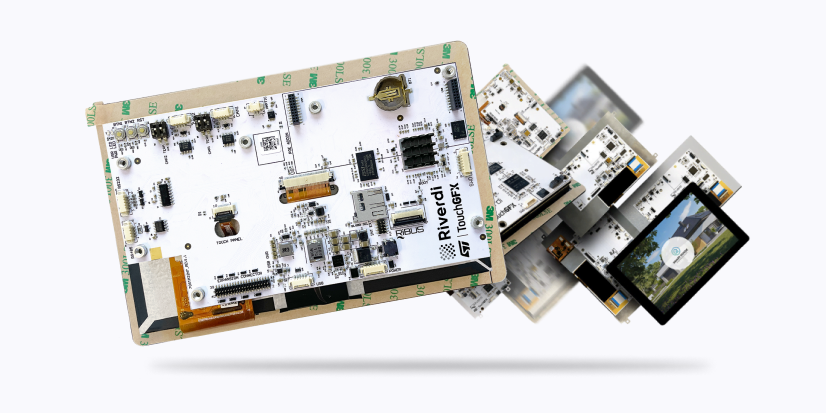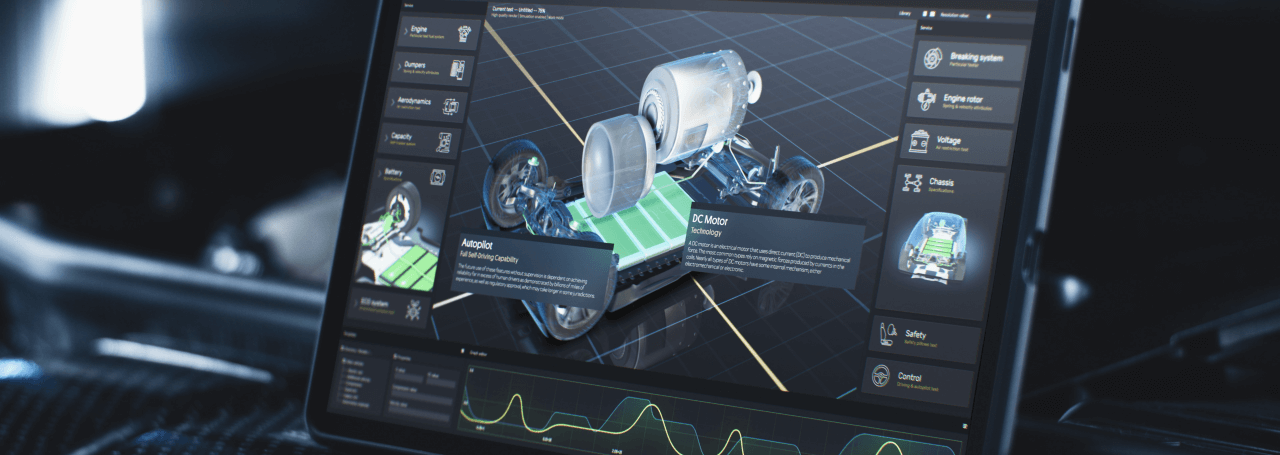- Fundamentals of display integration
- Planning and preparation for display selection
- The fastest Time-to-Market with off-the-shelf solutions
- Customized vs. standard displays and work in parallel systems
- Display technology selection
- Evaluation and prototyping solutions
- Riverdi as your implementation partner
- Conclusion
PART 1.
From mechanics and electronics to optical performance
In this article you will explore key considerations in the display integration process, with practical insights to accelerate the implementation process. You will also learn best practices in using standard product solutions and customization for industrial applications. Topics covered:
- Fundamentals of defining the display’s application
- Key considerations for the display selection
- How to accelerate product development and reduce costs
- When to choose standard or customized solutions
- How to select the display technology
- Evaluation and prototyping solutions
Fundamentals of display integration
Display implementation involves multiple aspects, including mechanical, electronic and optical performance. The process begins with defining the application and use case:
- Indoor vs. outdoor usage: outdoor applications require high brightness and vandal-proof protection.
- User Interaction: will the display feature touch functionality, buttons, or serve as an information-only screen?
- Resolution & size: determined by the type of information displayed (e.g., graphs vs. numeric data).
| Real-world examples highlighting these considerations | |
| Parcel lockers (outdoor) | Require high brightness displays (>1000 nits) with vandal-proof protection and weatherproofing |
| Medical diagnostic equipment (indoor) | Demands color accuracy, consistent backlighting, and often antimicrobial surfaces |
| Factory control panels (industrial) | Need wide operating temperature ranges and resistance to vibration |
Understanding these parameters early on streamlines the selection and integration process.
Planning and preparation for display selection
Proper planning is critical to avoid costly design modifications later in the process. In this phase, key considerations should include:
| Parameter | Consideration |
| Application | Industrial, medical, military or consumer |
| Size | Typically ranges from 1″ to 12″ depending on use case |
| Resolution | High resolution for detailed graphics, lower for simple UI |
| Touch support | Required for interactive devices, optional for displays with external controls |
| Interface | LVDS, MIPI, SPI, HDMI or embedded solutions |
| Technology | TFT LCD or specialized industrial displays |


The fastest Time-to-Market with off-the-shelf solutions
To accelerate product development and reduce costs, selecting standard, ready-made display modules is often the best choice. Riverdi has developed hundreds of pre-designed models, each accompanied by:
| Engineering resources and integration tools | |
| Comprehensive documentation | Datasheets, mechanical drawings, and specifications |
| 3D models | Allowing engineers to integrate the display into their enclosure designs |
| Firmware examples | Sample code to simplify software integration |
| Application notes | Providing electrical schematics and backlight driving guidance |
Moreover, Riverdi’s ready-made models come with various interface options, offering flexibility to suit your system architecture:
- LVDS/MIPI displays: ideal for embedded systems requiring high-speed data transfer and complex graphics
- SPI-driven intelligent displays: perfect for systems where a simple host processor can offload graphics processing to the display itself (like the EVE 4 series)
- STM32 Embedded displays: all-in-one solutions with integrated driving boards, minimizing development complexity
- HDMI displays: plug-and-play solutions for rapid prototyping or systems using standard computer interfaces
Comparing this to the opportunities that can usually be found in the market, this is the unique factor that positively influences the speed of implementation. Full accessibility of technological data is one of the pivotal benefits of using Riverdi’s off-the-shelf solutions, important especially for product development specialists. To summarize, this way engineers can:
- Select a display directly from the Riverdi website with parameters that perfectly match your project’s requirements
- Download technical files without registration
- Get evaluation kits for rapid testing
Customized vs. standard displays and work in parallel systems
While standard displays offer immediate implementation, some applications require personalized solutions. The decision to customize depends on the production volume and specific technical requirements. The table below summarizes the fundamental factors that determine the validity of customization.
| Customization factor | Consideration |
| Modifications | Adjusting the cover glass, interface and PCB design to meet the requirements of:
|
| Lead time | Timing depends on project readiness.
|
| Prototype strategy | For cost-effective, large-scale production (e.g. 1000+ devices), the most efficient approach is to start with a standard display solution.
|
The volume thresholds for customization vary depending on the type and extent of modifications required. While full customization (including display panel, cover glass, PCB and interfaces) typically requires volumes of 1000+ units annually, Riverdi offers flexibility for different project scales. For larger display sizes, customization may be feasible with volumes as low as 500 units. If your customization needs are limited to the PCB or interface components while using standard display panels, the threshold can be lower—potentially in the 200-300 unit range. This tiered approach ensures that even medium-scale projects can benefit from some level of display optimization.
| Minimum order quantity for customized vs. standard displays | |
| Full customization (standard) | 1000+ units per year |
| Full customization (larger displays) | Minimum 500 units |
| PCB/Interface customization only | As low as 200-300 units |
| Standard products | No minimum requirement |
Another key advantage of the Riverdi approach is the ability to work in parallel streams. While your customized display is being manufactured, your engineering team can develop software and test integrations using identical standard displays. This parallel development path ensures that when your customized displays arrive, the implementation is already validated and ready for final testing— saving weeks or even months in your development timeline. All in all, customization ensures optimal performance in mass production but should be approached only when necessary to balance cost and efficiency.
Display technology selection
The choice of display technology is fundamental to system performance. For industrial and embedded applications, TFT LCD remains the preferred option due to its stability, longevity, and cost-effectiveness. However, in certain cases, OLED may be considered for smaller screens displaying simple content.
| Technology | Best use cases | Advantages |
| TFT LCD | Industrial, medical, military | Long lifespan, high reliability |
| OLED | Small consumer devices | High contrast, vibrant colors |


Evaluation and prototyping solutions
Before moving into full production, companies can buy accessories that are evaluation boards or plug-and-play HDMI displays to test functionality and performance.
- Evaluation kits: modular boards allowing engineers to test different display configurations
- HDMI Displays: useful for mock-ups and trade show demonstrations
- Quick prototyping: reduces time spent on firmware development
Riverdi as your implementation partner
Beyond providing display hardware, Riverdi offers expertise and support throughout the decision-making and implementation process:
- Technical consultation: engineering guidance on optimal display solutions for specific applications
- Documentation access: immediate availability of complete technical documentation without registration barriers
- Prototyping assistance: evaluation kits and support for rapid proof-of-concept development
- Long-term partnership: support from initial design through volume production and product lifecycle
This partnership approach ensures that engineering teams can make informed decisions quickly, with confidence that they’re selecting the optimal display technology for both immediate implementation and long-term product success.
Conclusion
The implementation of displays in embedded systems requires careful planning to ensure efficiency and cost-effectiveness. By choosing Riverdi’s pre-designed solutions, comprehensive documentation and rapid prototyping tools, engineering teams can:
- Reduce development cycles compared to traditional design approaches
- Decrease engineering hours spent on display integration and troubleshooting
- Minimize risks associated with custom design challenges
- Maintain flexibility for future production-scale customization
With a clear roadmap and Riverdi’s technical support, companies can streamline display integration, significantly reduce time-to-market, and achieve optimal product performance while controlling development costs.
CHECK OUT RIVERDI’S IMPLEMENTATION-READY PRODUCTS
Be sure to find the right industrial-grade display for your device:
- Need to enhance the brightness and optical performance of your display? Choose High Brightness IPS Displays with optical bonding that perfectly reduce the reflection and correct contrast.
- In search of the most effective data interchange between graphics and a truly industrial touch controller? Check BT817Q (EVE 4) product category with revolutionary communication protocol for industrial, medical and military applications requiring beautiful and sophisticated GUI.
- Looking for one of the highest resolution (1280×800 pixel) HMI displays based on STM32H7 MCUs? Choose STM32 Embedded Displays with high performance enabled by STM32H757XIH6 (2MB Flash, 1MB RAM) microcontroller.
- Need a plug and play HDMI interface and USB-C touch solution? Pick the HDMI Displays that are high-resolution, high-brightness IPS TFT products with optical bonding and industrial grade touch screen as Riverdi’s standard.
CONTACT US
Contact our expert to dive deeper into display implementation for your project.
Having issues with your current technology? Want to learn about frameworks and our clients’ success stories? We are happy to discuss and assist you with your design and R&D challenges.
DISCOVER OUR
Whitepaper
Achieve the perfect user-display interaction with the right Touch Sensor IC. Ever faced issues with phantom touch events or certification? Boost your R&D like a pro with our Whitepaper!



